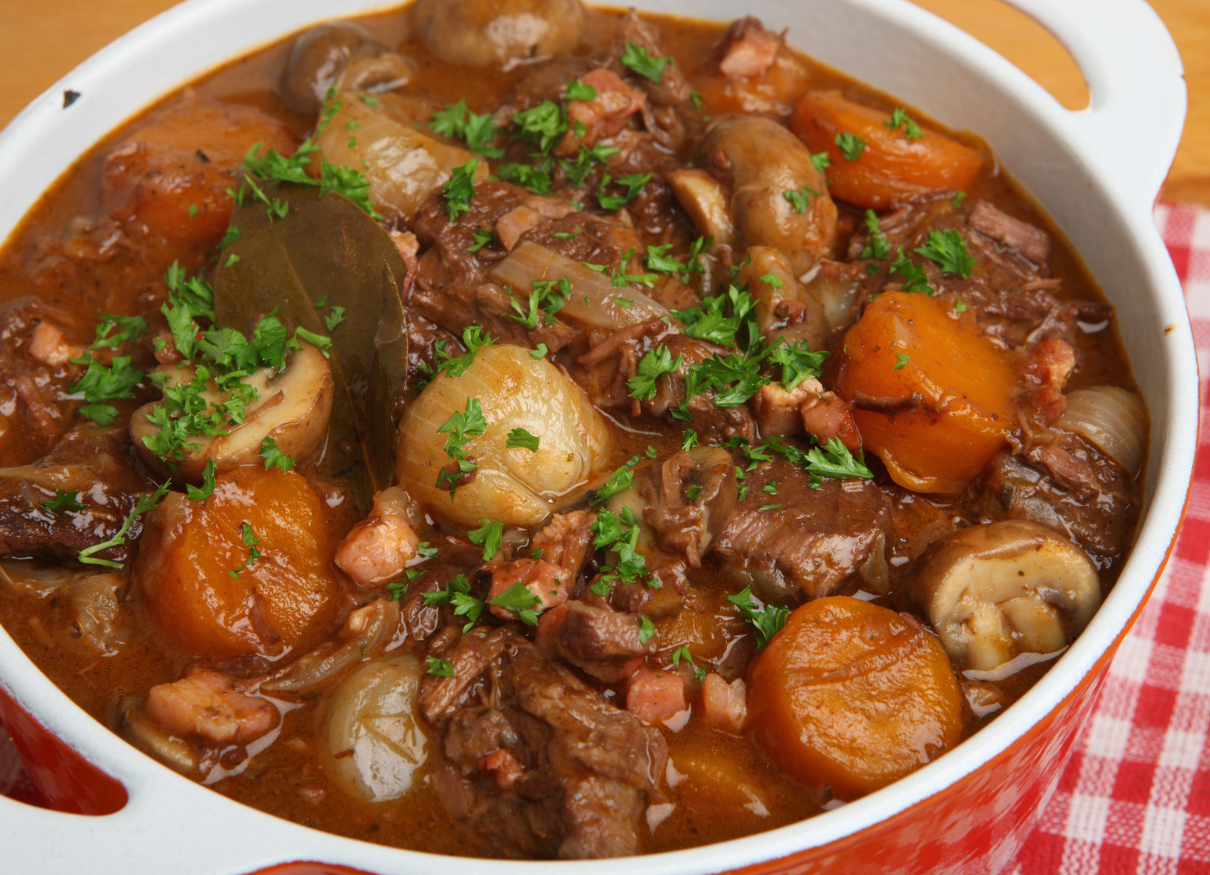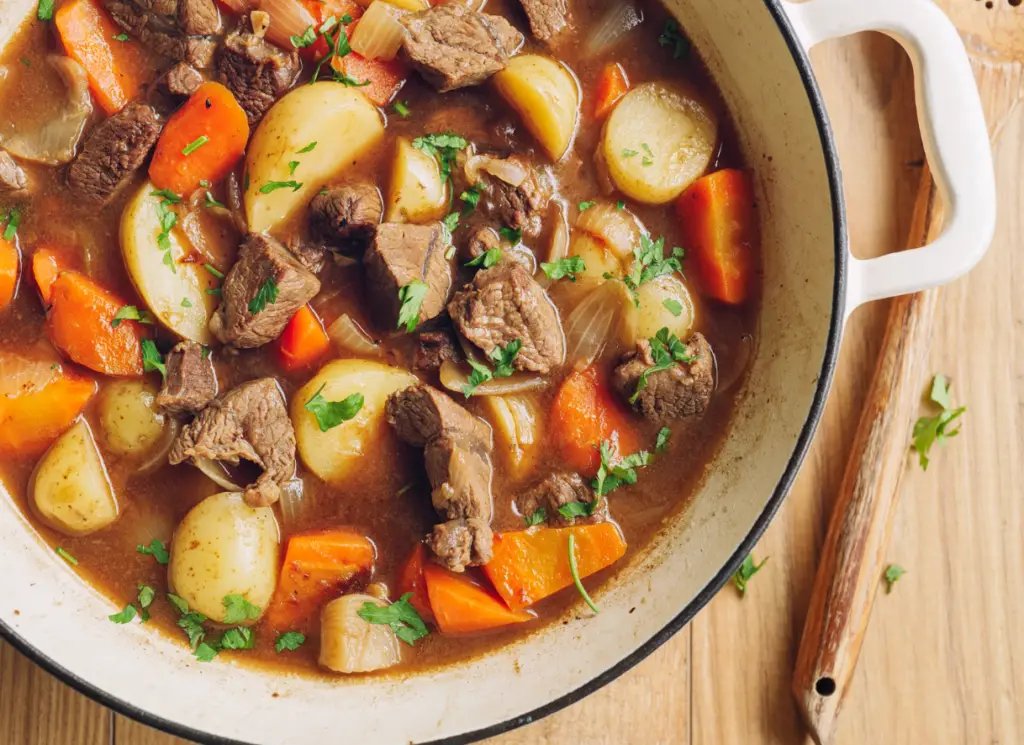Cowboy stew is more than just a hearty meal; it’s a culinary journey through American history. This rustic and flavorful dish has evolved from the simple, nourishing fare of frontier cowboys to a beloved staple in kitchens across the nation. In this comprehensive guide, we’ll explore the rich history, key ingredients, and cooking techniques that make cowboy stew a unique and cherished recipe. Whether you’re a seasoned cook or a beginner, this article will equip you with everything you need to master this classic American dish.
The Origins of Cowboy Stew
The Historical Roots
The story of our stew begins in the rugged landscapes of the American West. Originally a practical dish, it was designed to feed hungry cowboys on cattle drives. These early versions were simple, utilizing whatever ingredients were on hand – often beef, beans, and potatoes. Over time, cowboy stew became a symbol of American resilience and ingenuity.
Cultural Significance and Evolution
As the stew traveled across America, it absorbed local flavors and ingredients, becoming a melting pot of regional cuisines. From the smoky kielbasa of the South to the hearty beans of the Midwest, each version of cowboy stew tells a story of the people and places that shaped it. Today, it’s a testament to America’s diverse culinary landscape.
Regional Variations
In Texas, cowboy stew is often spiced up with chilies and cumin, reflecting the state’s Mexican influences. In the Midwest, you might find a sweeter version with corn and tomatoes. These regional twists not only add variety but also showcase the adaptability of this time-honored dish.
Key Ingredients
Meats: The Foundation of Flavor
In cowboy stew, meat is more than just an ingredient; it’s the heart and soul of the dish. Ground beef offers richness, while kielbasa sausage brings in a smoky depth. Bacon, with its crispy texture and salty punch, rounds out the meat trio. These meats not only provide hearty sustenance but also layer the stew with complex flavors.
Vegetables: Nutritious and Hearty
Vegetables play a crucial role in balancing the stew. Potatoes offer starchiness and comfort, corn adds a sweet crunch, and onions contribute a mild piquancy. Green peppers introduce a subtle bitterness that complements the meats. Together, these vegetables create a harmonious blend of tastes and textures.
Beans and Legumes: A Rustic Touch
Beans are a staple in cowboy stew, adding protein and heartiness. Whether it’s the creamy texture of pinto beans or the earthy flavor of black beans, they enrich the stew with fiber and nutrients.
Seasonings and Spices: The Flavor Enhancers
The right blend of seasonings and spices can transform cowboy stew from good to extraordinary. Common choices include garlic for aroma, cumin for warmth, and chili powder for a spicy kick. These seasonings not only enhance the flavors but also pay homage to the stew’s Southwestern roots.
Step-by-Step Cooking Guide

Detailed Instructions for Making Cowboy Stew
- Gather Ingredients: Start by assembling all your ingredients. You’ll need meats like ground beef, kielbasa sausage, and bacon; vegetables such as potatoes, corn, onions, and green peppers; beans like pinto or black beans; and a mix of spices including garlic, cumin, and chili powder.
- Prep Work: Chop your vegetables into bite-sized pieces, slice the meats, and measure out your spices. Proper preparation makes the cooking process smoother and more efficient.
- Browning the Meats: In a large pot or Dutch oven, brown the meats over medium heat. This step is crucial for developing deep flavors.
- Sautéing Vegetables: After removing the meats, use the same pot to sauté the vegetables until they’re just soft.
- Combining Ingredients: Return the meats to the pot, add the beans, spices, and enough broth to cover the ingredients.
- Simmering: Let the stew simmer on low heat for at least an hour, allowing the flavors to meld together. Stir occasionally and add more broth if needed.
Ingredients List
- Ground beef
- Kielbasa sausage
- Bacon
- Potatoes
- Corn (fresh or canned)
- Onions
- Green peppers
- Pinto or black beans
- Garlic
- Cumin
- Chili powder
- Beef or chicken broth
Cooking Tips and Techniques
- Layering Flavors: Start with browning the meats and then cooking the vegetables in the same pot to build layers of flavor.
- Simmering: Allow the stew to simmer slowly to tenderize the meat and meld the flavors.
- Thickness: Adjust the thickness of the stew by adding more broth for a thinner consistency or letting it simmer longer to thicken.
Variations in Cooking Methods
- Stovetop: The traditional method, perfect for simmering the stew slowly over a couple of hours.
- Slow Cooker: Combine all ingredients in the slow cooker and cook on low for 6-8 hours or high for 3-4 hours.
- Instant Pot: Use the sauté function to brown the meats and vegetables, then pressure cook for about 30 minutes. Watch this engaging video, ‘The Shocking Truth Behind Cowboy Stew Revealed!,’ to uncover fascinating facts and stories about cowboy stew.
Adjusting Flavors and Seasoning
- Taste as You Go: Regularly taste the stew and adjust the seasoning as needed.
- Spice Level: Adjust the amount of chili powder or add hot sauce to reach the desired spice level.
- Herbs: Fresh herbs like parsley or cilantro can be added towards the end for a fresh flavor boost. Learn more about the historical context of cowboy stew with this article on 1890s Chuckwagon Beef Stew, which offers a glimpse into the culinary practices of the era.
This comprehensive guide provides detailed instructions, an ingredients list, cooking tips, and variations for making cowboy stew, ensuring a delicious and satisfying meal.
Nutritional Information

Health Benefits of Key Ingredients
Cowboy stew is not just a treat for the taste buds; it’s also packed with nutritional benefits. The meats in the stew are excellent sources of protein and essential amino acids, vital for muscle growth and repair. Vegetables like potatoes and corn provide fiber, vitamins, and minerals, supporting overall health. Beans add to the stew’s fiber content, promoting digestive health. For more insights into the health benefits of key ingredients, consider exploring our guide on adapting thin chicken breast recipes for every diet, which discusses using leaner meats for healthier cooking.
Caloric Content and Dietary Considerations
While cowboy stew is hearty and filling, it’s important to be mindful of its caloric content, especially for those monitoring their dietary intake. The meats, particularly if fatty cuts are used, can add significant calories. However, by making mindful choices, such as opting for leaner meats or reducing the amount of bacon, the caloric content can be managed effectively. For a deeper understanding of the dish’s historical context and its evolution, including how dietary habits have changed, check out Texini’s article on cowboy stew.
Making Cowboy Stew Healthier (Low-Fat, Low-Carb Options)
To make a healthier version of cowboy stew:
- Low-Fat Options: Use lean cuts of beef, turkey sausage instead of kielbasa, and limit or omit the bacon.
- Low-Carb Alternatives: Replace potatoes with low-carb vegetables like cauliflower or turnips.
- Increase Vegetables: Add more vegetables like carrots, celery, or bell peppers to increase the stew’s fiber and nutrient content.
- Use Low-Sodium Ingredients: Opt for low-sodium beans and broth to reduce the overall salt content. For additional tips on making hearty dishes healthier, watch ‘The Shocking Truth Behind Cowboy Stew Revealed!,’ which may offer unique perspectives on modifying traditional recipes.
Pairing Cowboy Stew with Sides
Recommended Side Dishes
Cowboy stew pairs wonderfully with a variety of side dishes that complement its rich and hearty flavors.
- Cornbread: A classic choice, cornbread adds a sweet and crumbly texture that contrasts beautifully with the stew’s robustness.
- Green Salad: A crisp, fresh green salad can provide a refreshing balance to the hearty stew.
- Roasted Vegetables: Consider serving cowboy stew with a side of roasted vegetables like carrots or Brussels sprouts for an added nutritional boost.
Ideas for Turning It into a Complete Meal
To turn cowboy stew into a complete and satisfying meal:
- Add a Starch: Serve it over a bed of rice, quinoa, or mashed potatoes to soak up the delicious stew juices.
- Include a Bread Option: Offer a basket of warm, crusty bread or garlic toast for dipping into the stew.
- Finish with a Simple Dessert: A light dessert, like fruit salad or a scoop of ice cream, can be a perfect end to the meal.
Serving Suggestions for Different Occasions
Cowboy stew is versatile enough to suit various occasions:
- Casual Family Dinners: Serve it in large bowls with a side of cornbread for a cozy, family-friendly meal.
- Outdoor Gatherings: In a nod to its origins, cowboy stew is perfect for outdoor events like barbecues or campfires, served in rustic, heat-proof mugs.
- Formal Gatherings: Present the stew in elegant terrines or bowls, garnished with fresh herbs, for a more sophisticated touch.
FAQs
What is Cowboy Stew?
Cowboy stew is a hearty, one-pot meal traditionally made by cowboys during cattle drives. It typically includes a mix of meats like beef, sausage, and sometimes bacon, combined with vegetables such as potatoes, corn, and onions, all simmered in a flavorful broth. It’s known for its robust flavors and adaptability to different ingredients.
Can Cowboy Stew Be Made Vegetarian?
Absolutely! To make a vegetarian version of cowboy stew, replace the meats with plant-based proteins like beans, lentils, or tofu. You can also add more vegetables and use a vegetable broth to maintain the stew’s hearty nature.
Is Cowboy Stew Gluten-Free?
Cowboy stew can be gluten-free, but it depends on the ingredients used. If you’re using store-bought broth or canned beans, check the labels for any hidden gluten. Also, be mindful of the sausage and any added seasonings, as they might contain gluten.
How Can I Store and Reheat Cowboy Stew?
Cowboy stew can be stored in the refrigerator for up to 3-4 days. Make sure it’s in a covered container. For reheating, simply warm it on the stove over medium heat, adding a little water or broth if it’s too thick. Cowboy stew can also be frozen for up to 3 months. Thaw it in the fridge overnight before reheating.
What Are Some Common Misconceptions About Cowboy Stew?
- It’s Only for Winter: While cowboy stew is perfect for colder months, it’s versatile enough to be enjoyed year-round with seasonal ingredients.
- It’s Unhealthy: Cowboy stew can be made healthier by using lean meats, increasing the vegetable content, and controlling the portion sizes. It’s a misconception that it’s inherently unhealthy.
These FAQs address common queries and misconceptions about cowboy stew, providing clarity and helpful tips for those interested in making this classic dish.
Across America
Regional Variations and Local Favorites
From Texas to the Midwest, cowboy stew has taken on local flavors and ingredients. In Texas, it’s often spicier, while in the Midwest, it might include sweet corn or tomatoes. These regional variations not only add diversity but also reflect the local culture and tastes.
Stories and Anecdotes from Different States
In Texas, cowboy stew is a staple at rodeos and outdoor events, often cooked in large pots over open fires. In the Midwest, it’s a comfort food served during family gatherings, each family adding their unique twist to the recipe.
Tips and Tricks for the Perfect Cowboy Stew
Expert Advice and Chef’s Secrets
- Layering Flavors: Start by cooking the meats and vegetables separately to develop depth in flavors.
- Balancing Spices: Adjust spices like cumin and chili powder gradually. It’s easier to add more than to fix an overly spiced stew.
- Slow Cooking: Allow the stew to simmer slowly. This melds the flavors and tenderizes the meats.
Common Mistakes to Avoid
- Overcrowding the Pot: Give your ingredients enough space to cook evenly. Overcrowding can lead to uneven cooking.
- Rushing the Cooking Process: Patience is key. Rushing can result in undercooked vegetables or tough meat.
- Skipping the Tasting Step: Regularly taste your stew and adjust seasonings as needed. This ensures a balanced and flavorful outcome.
How to Store and Reheat Leftovers
- Storing: Cool the stew completely before storing it in airtight containers.
- Reheating: Gently reheat on the stove or in a microwave, adding a bit of broth if the stew has thickened too much.
Conclusion
In this comprehensive guide, we’ve journeyed through the rich history and culinary delights of cowboy stew. From its rustic origins to the modern kitchen, this dish remains a testament to American ingenuity and comfort cooking. With the tips, tricks, and insights provided, you’re now equipped to create your own hearty and flavorful cowboy stew. Whether for a cozy family dinner or a festive gathering, this versatile dish is sure to satisfy and impress. So, grab your pot and let the adventure begin!
